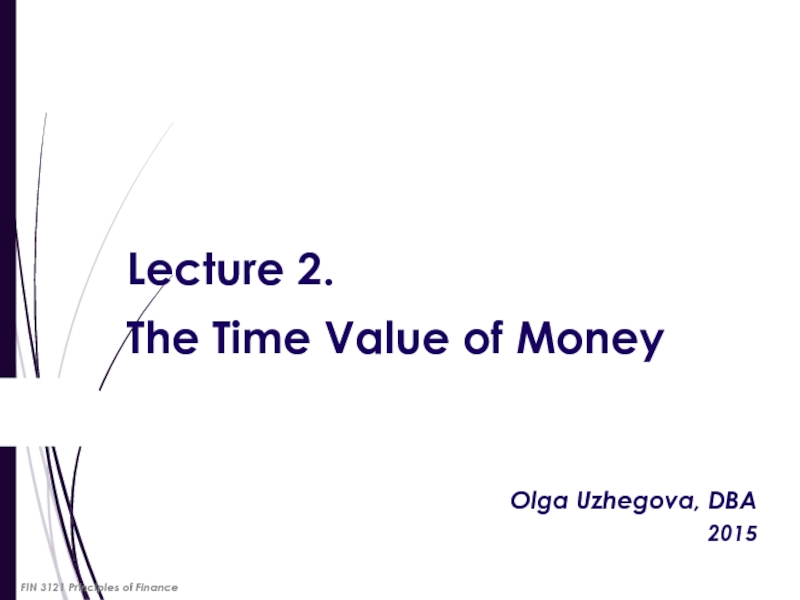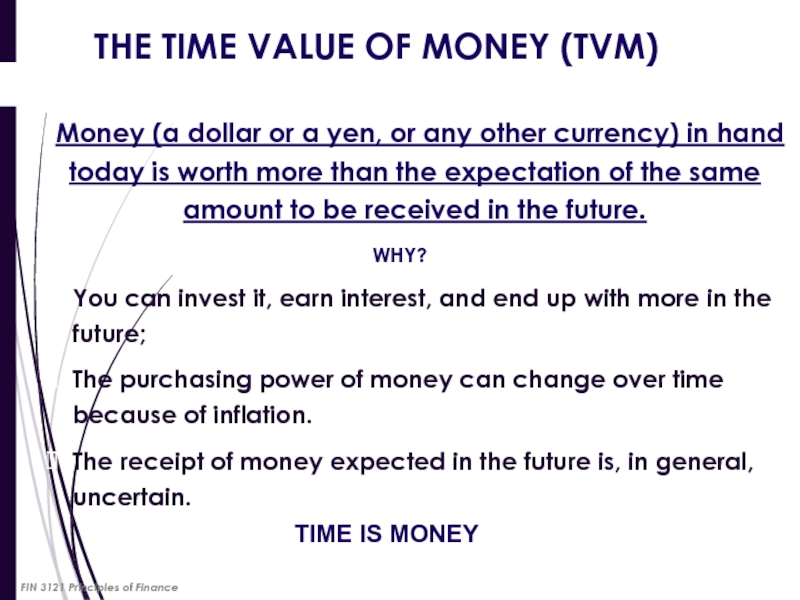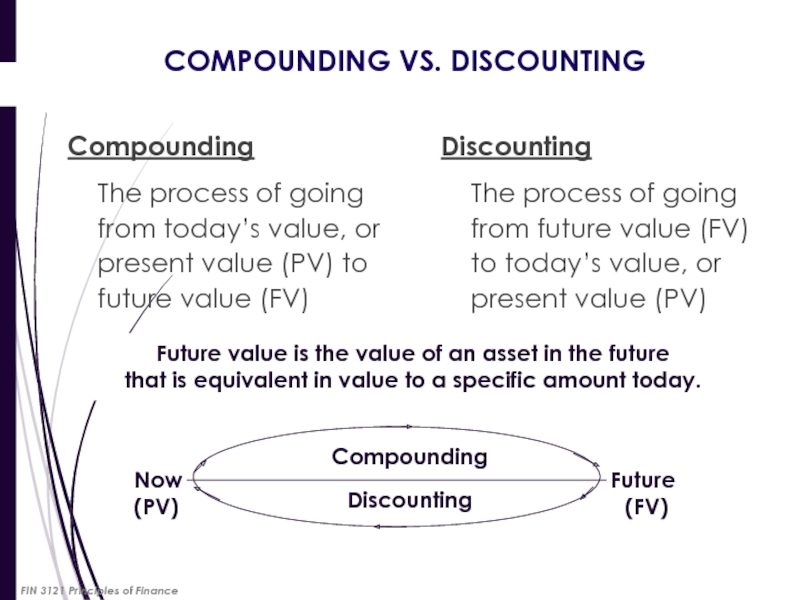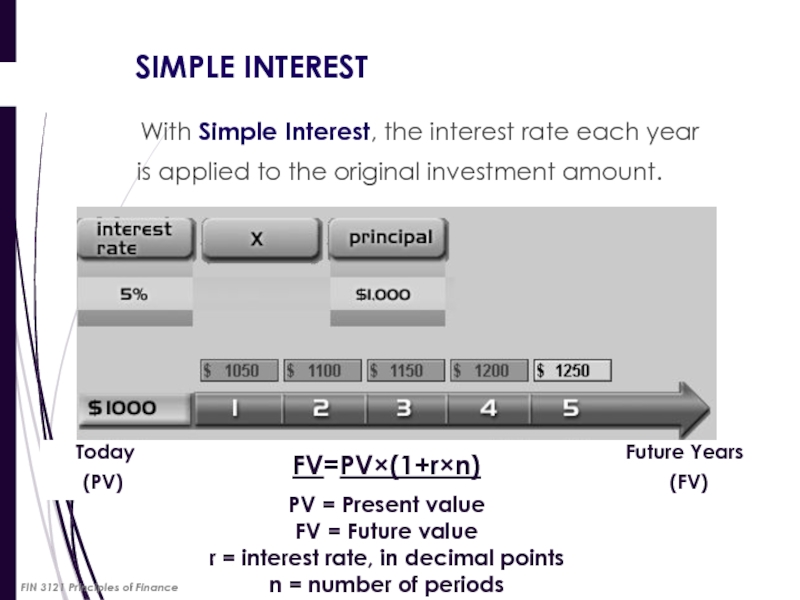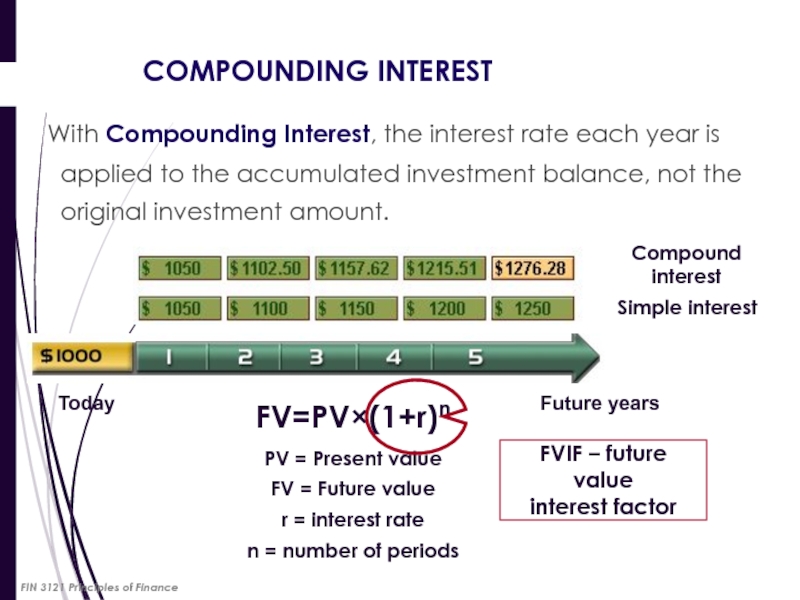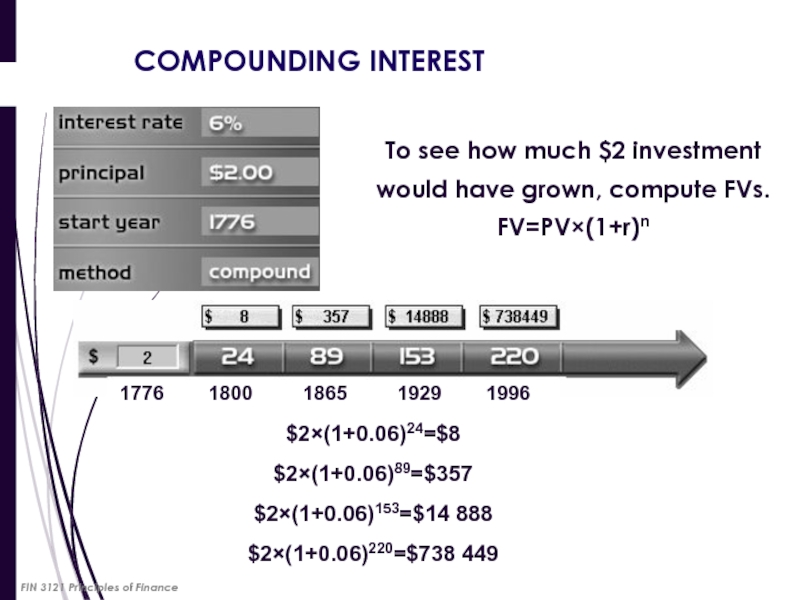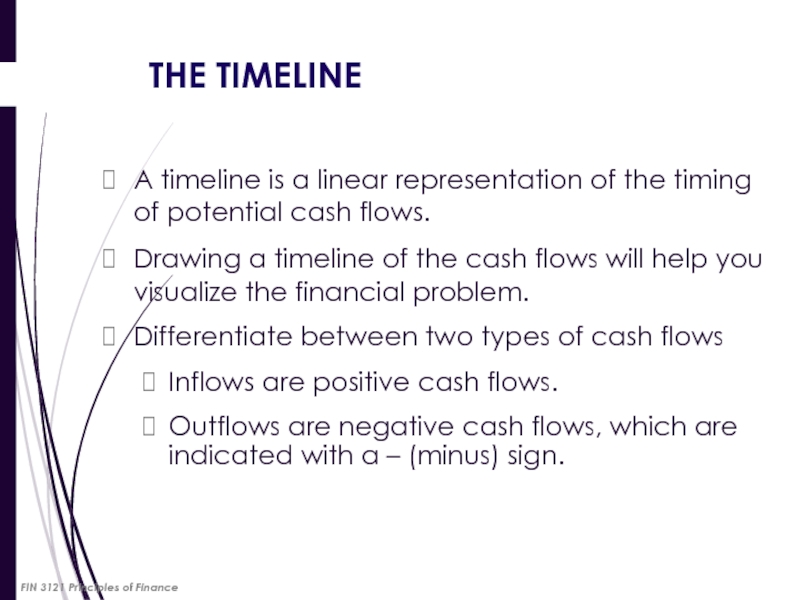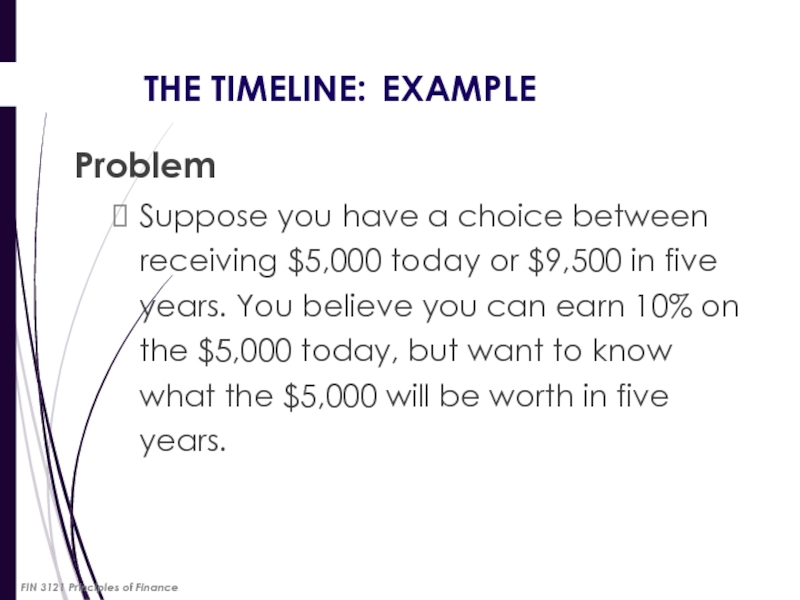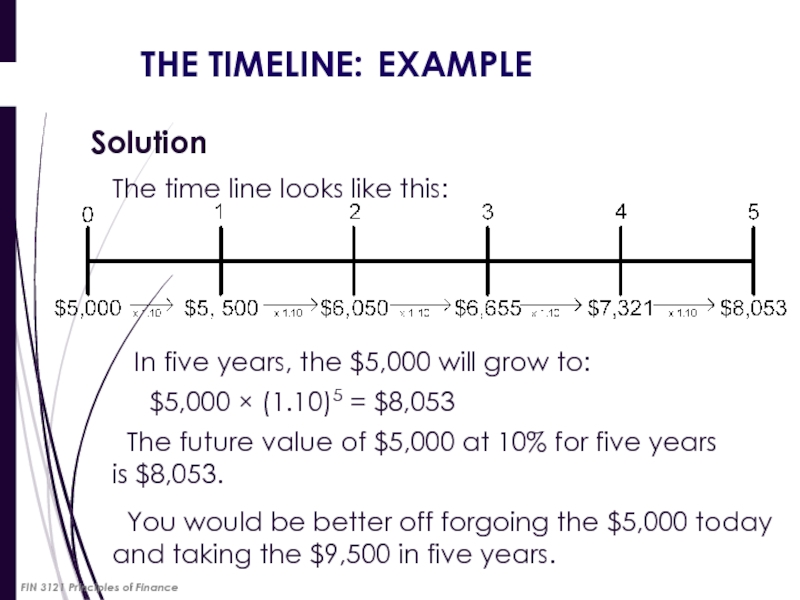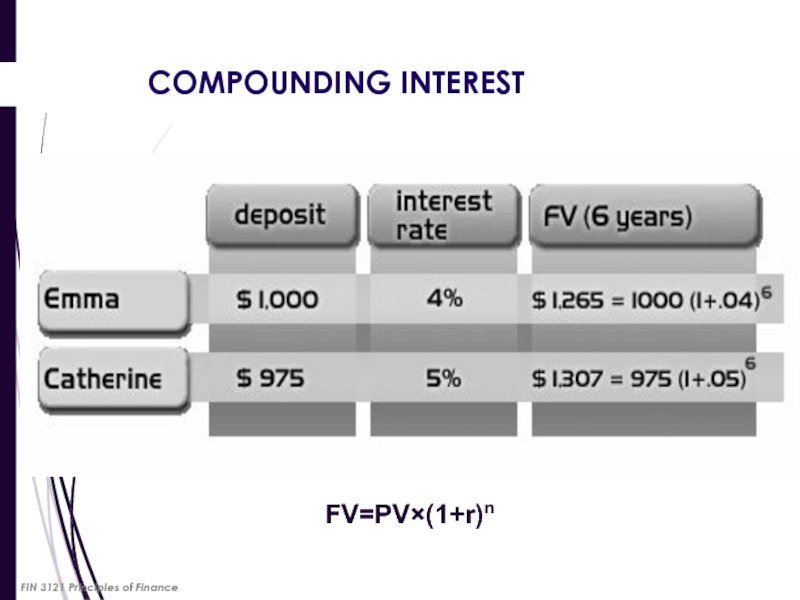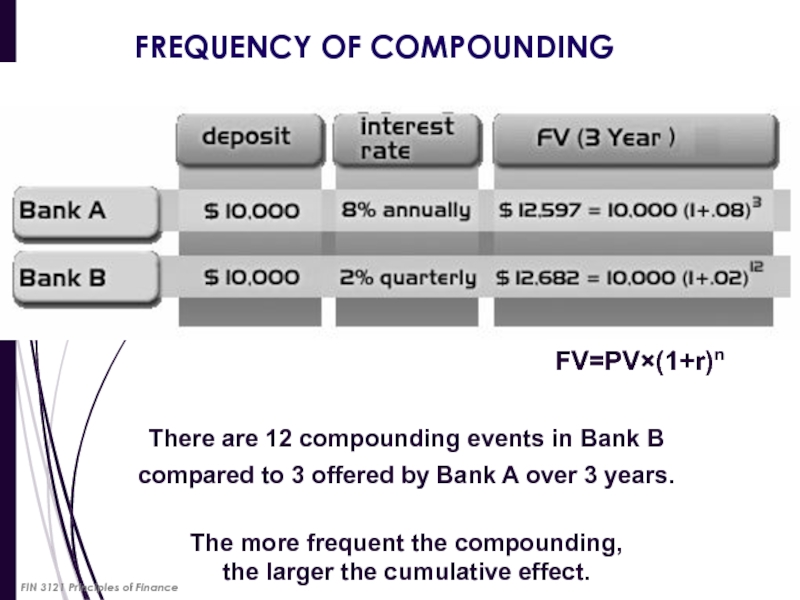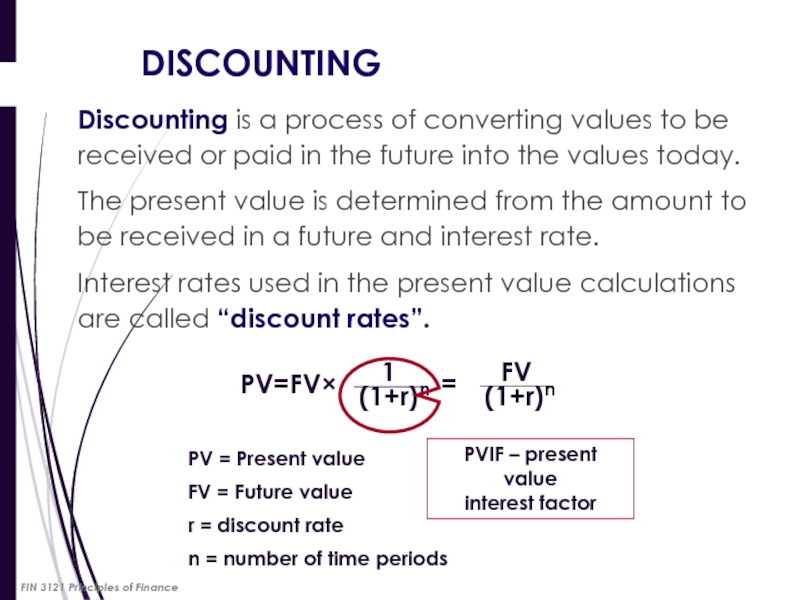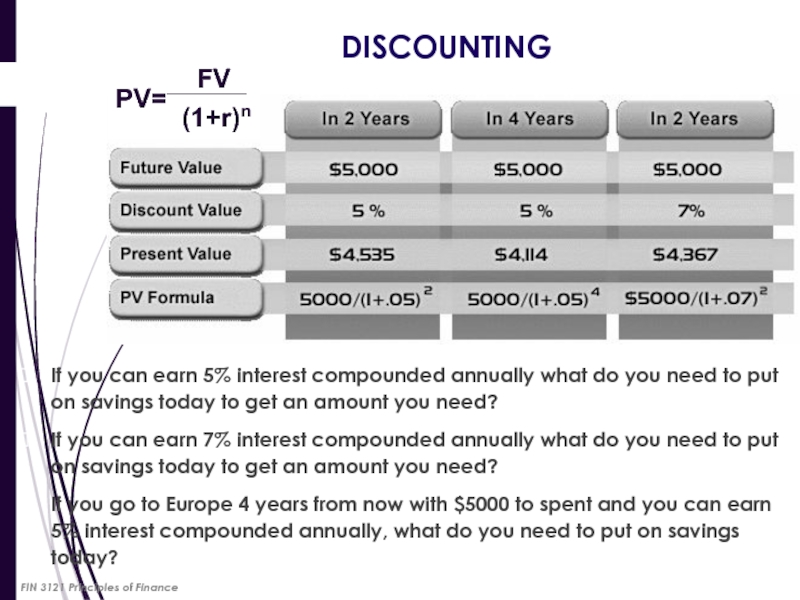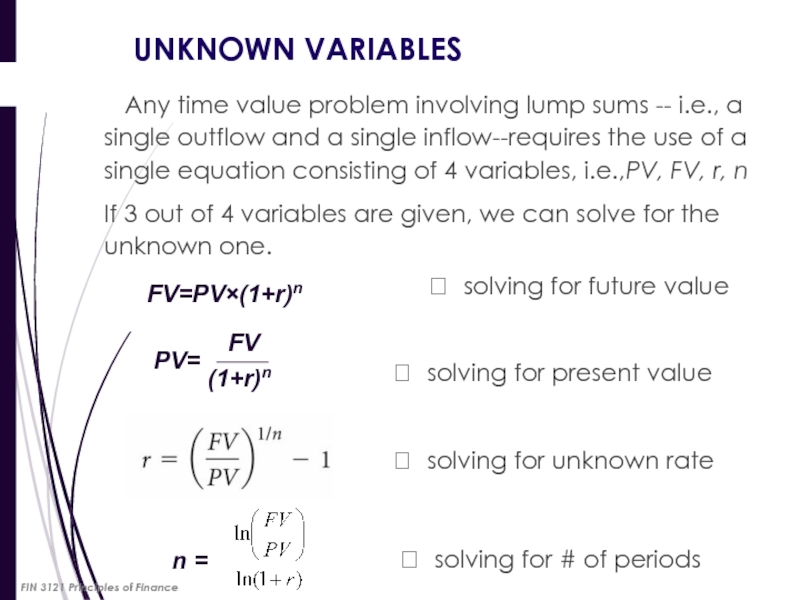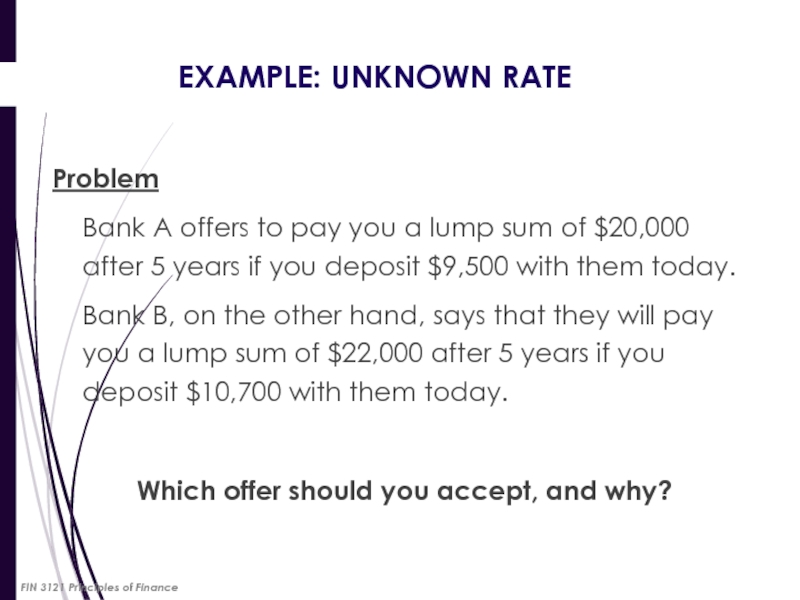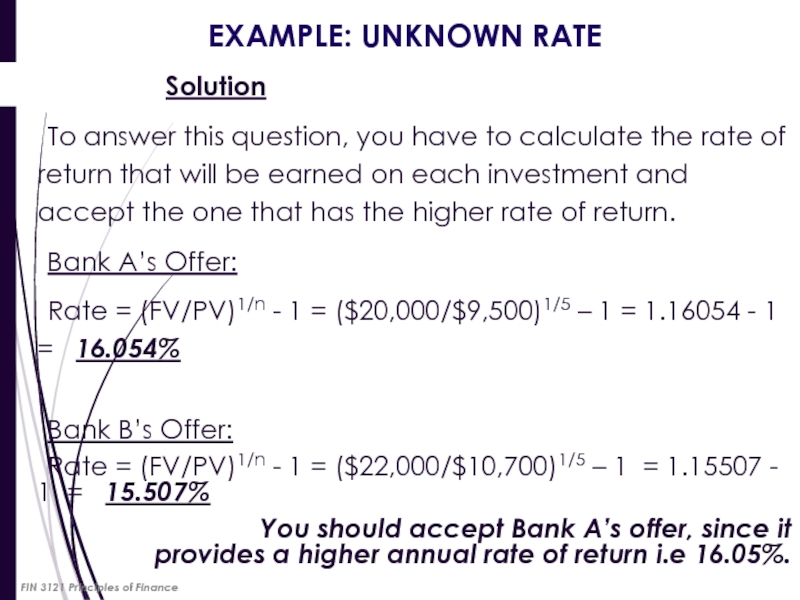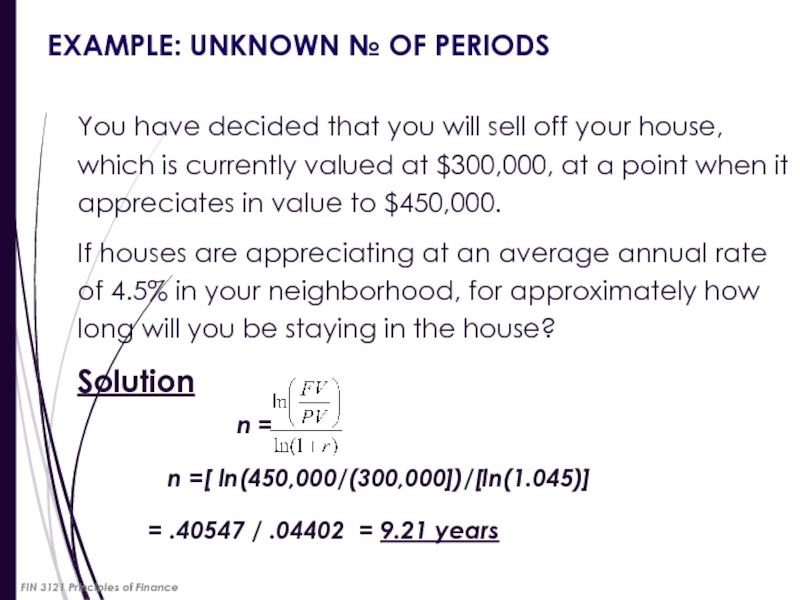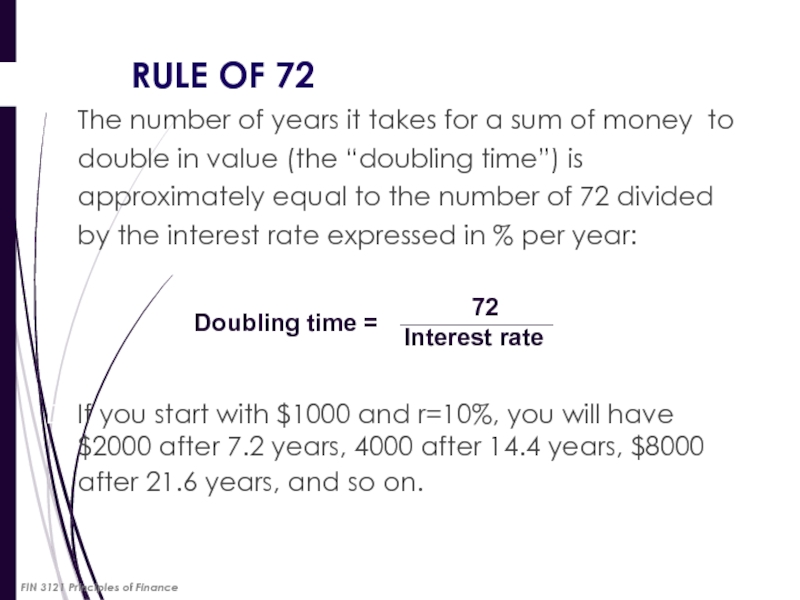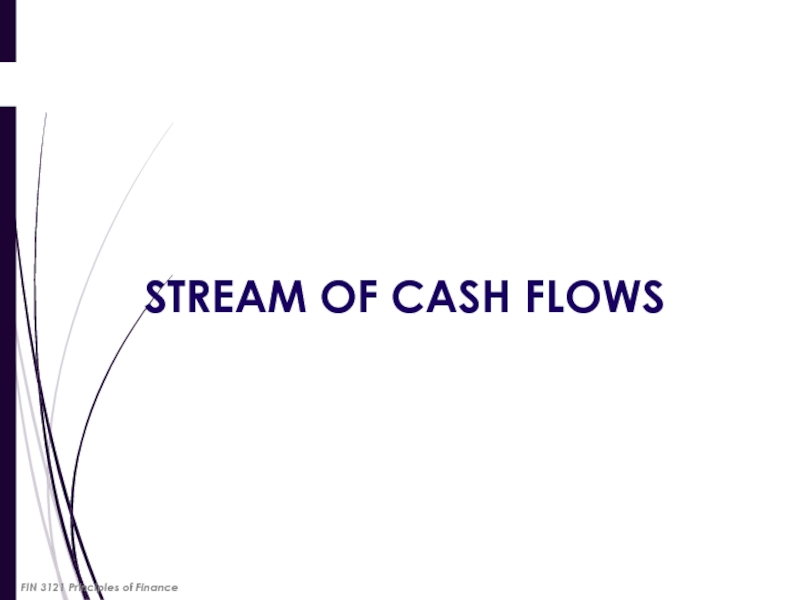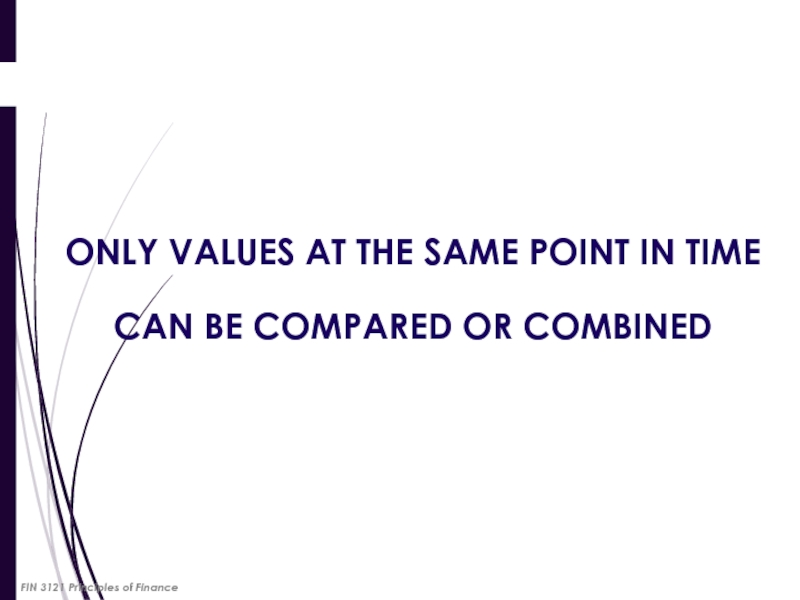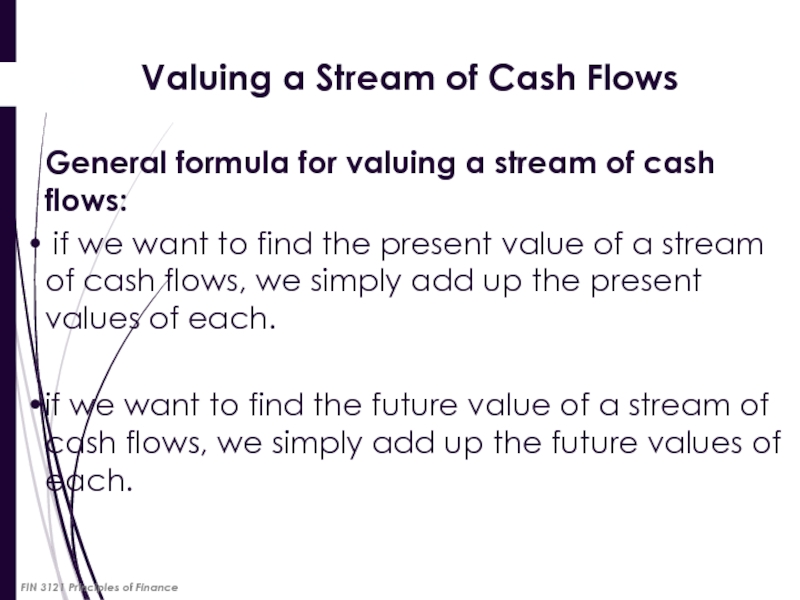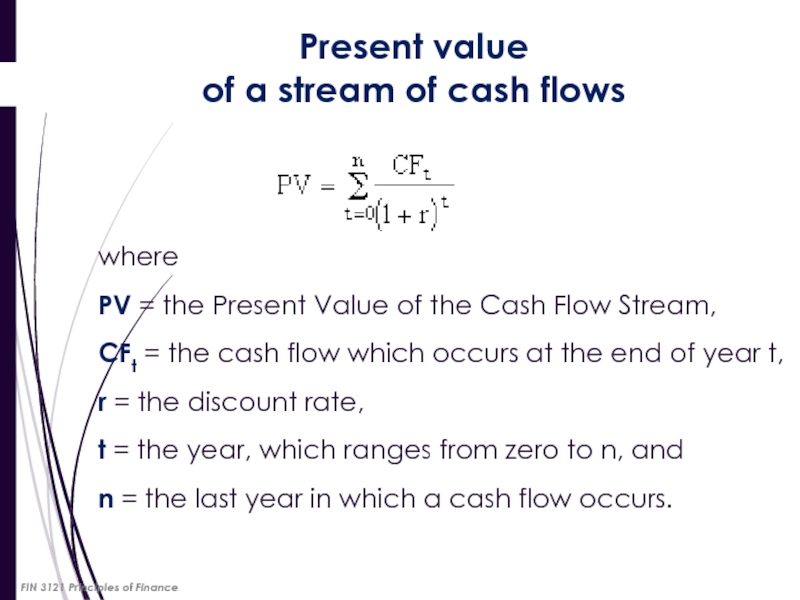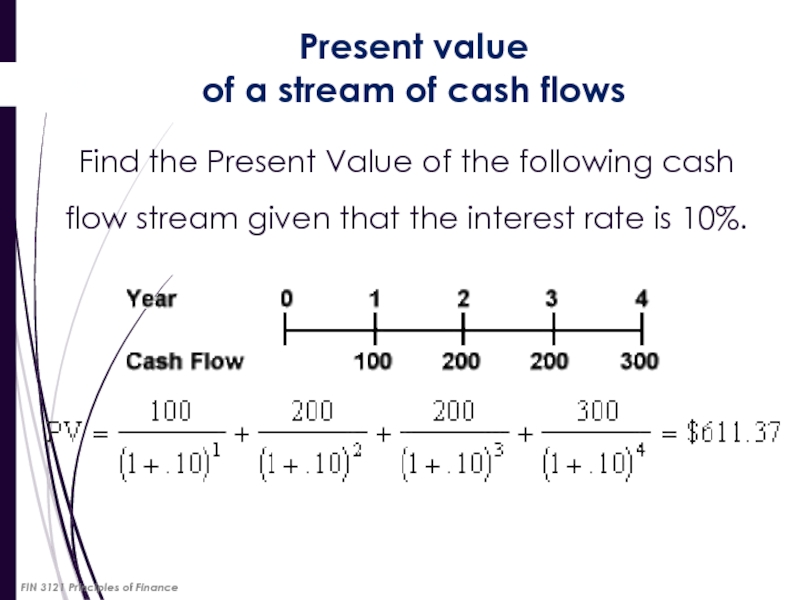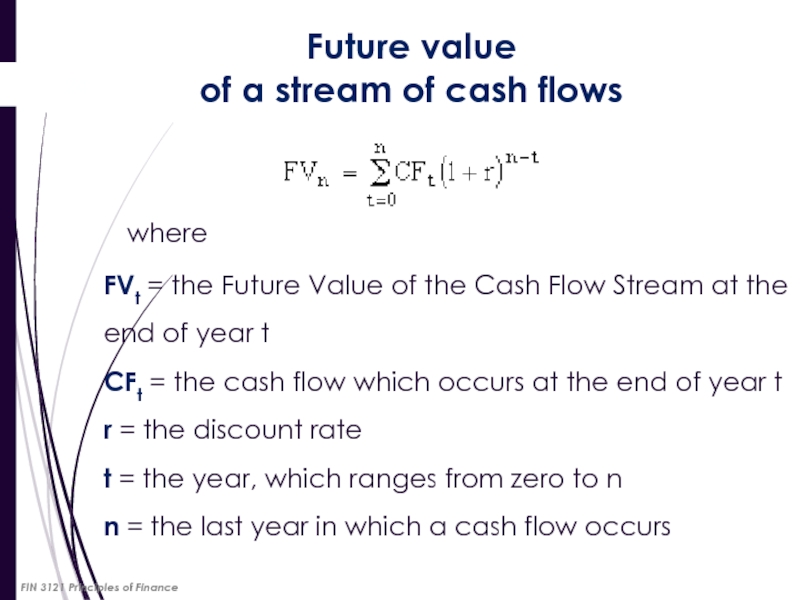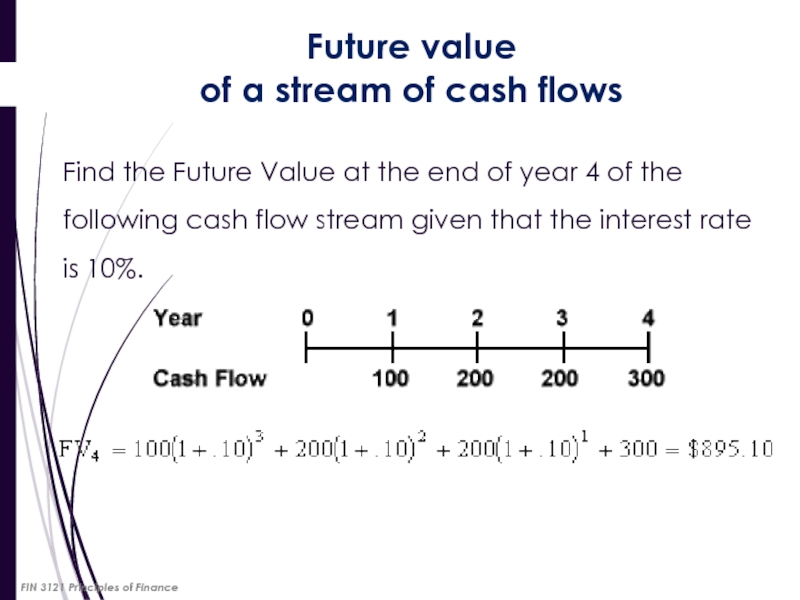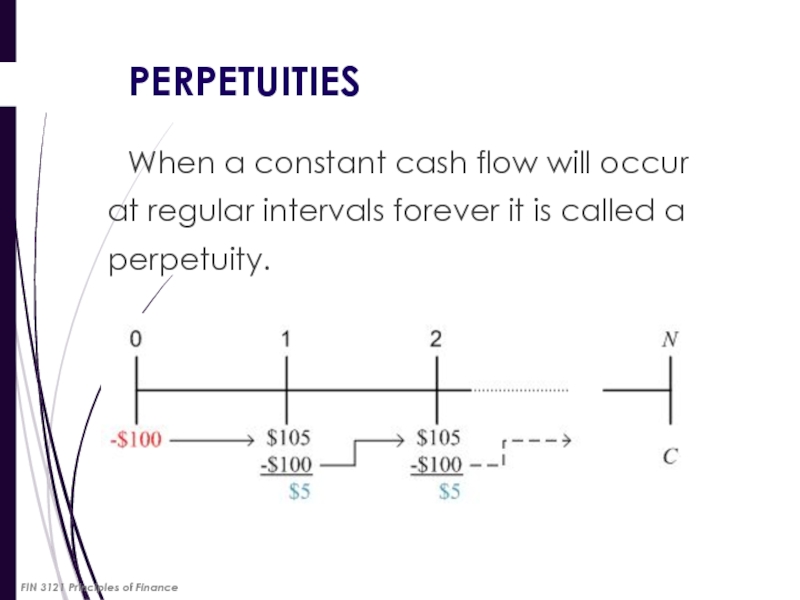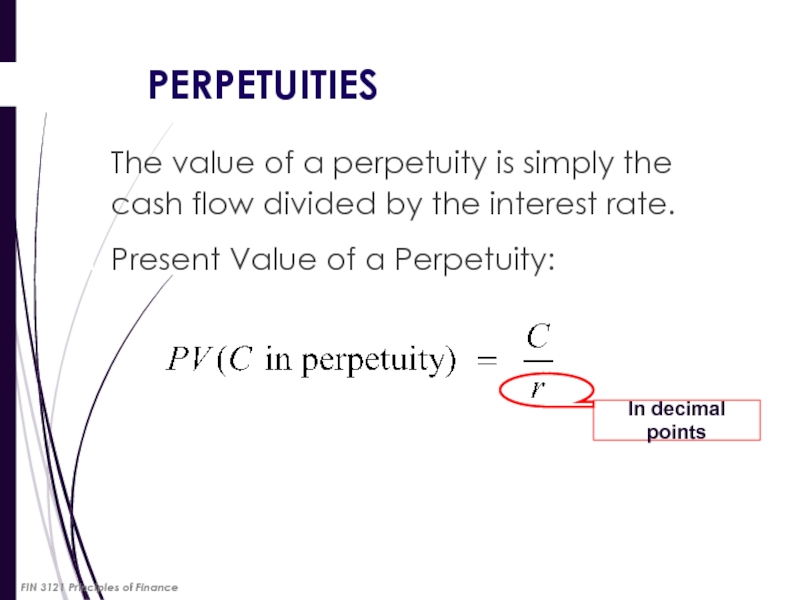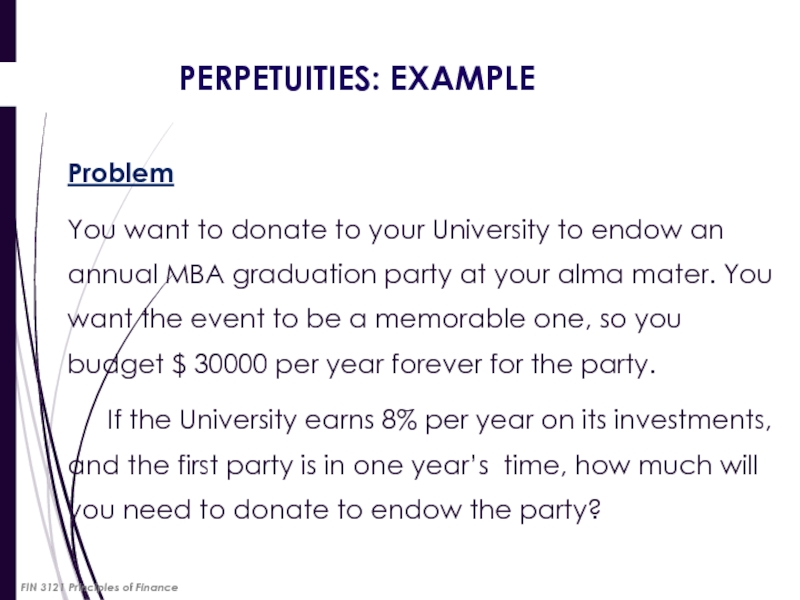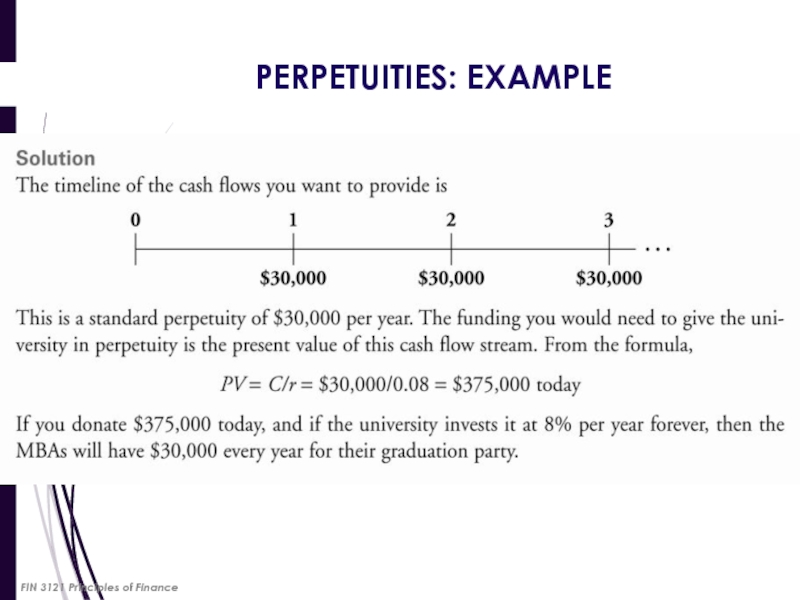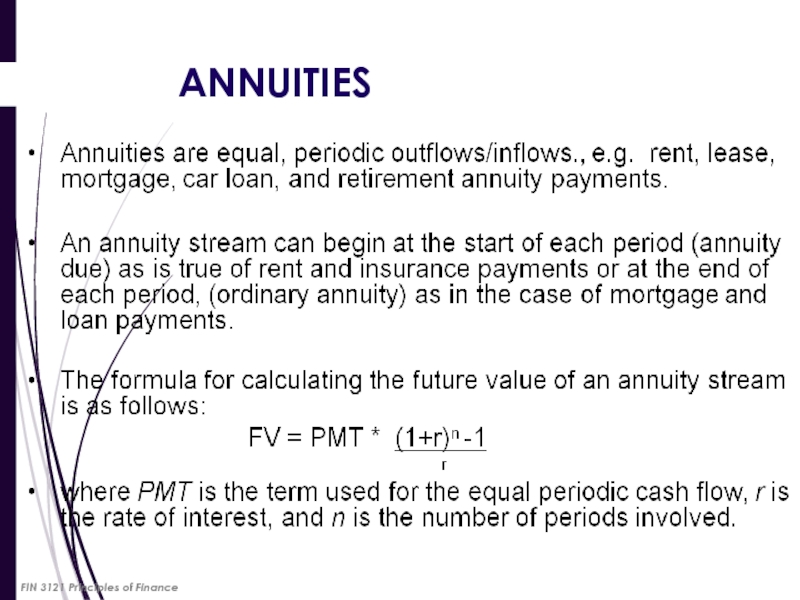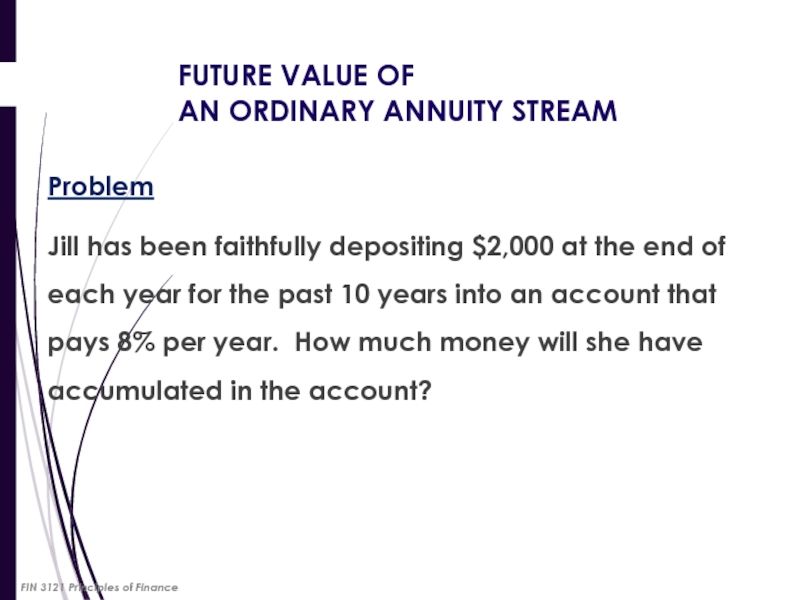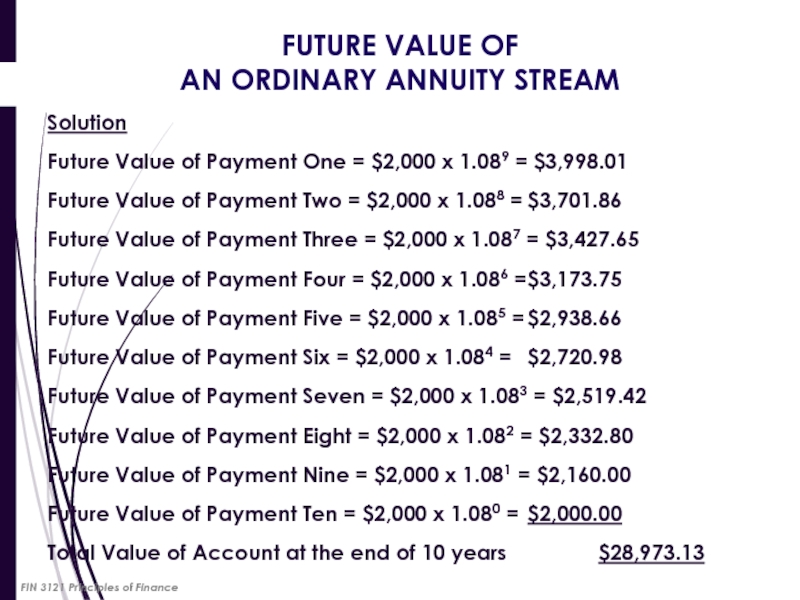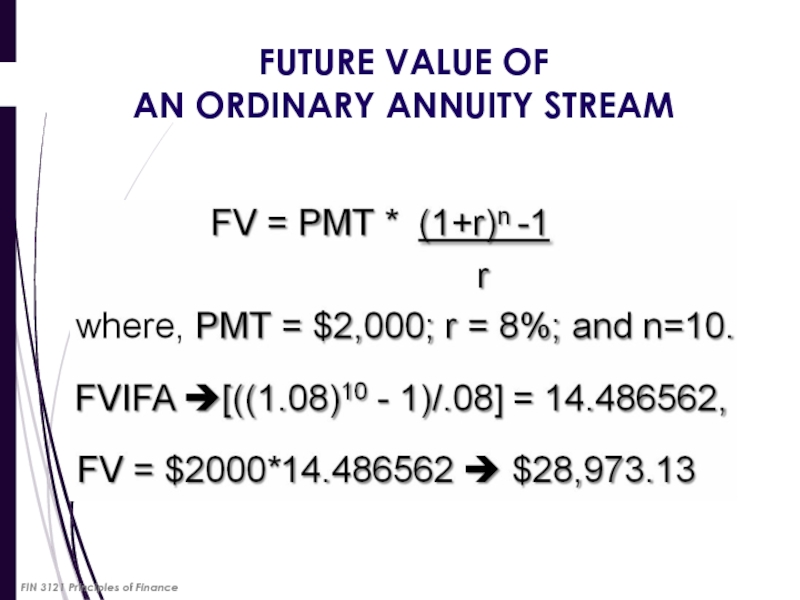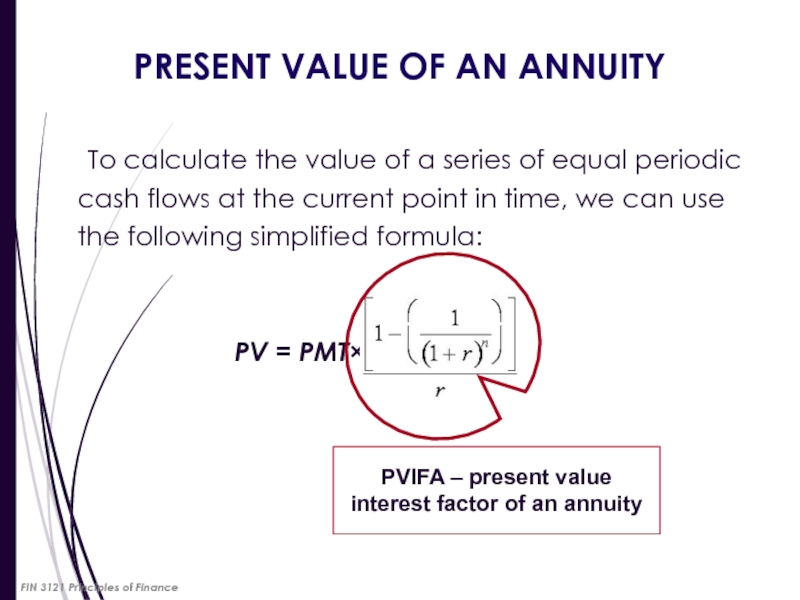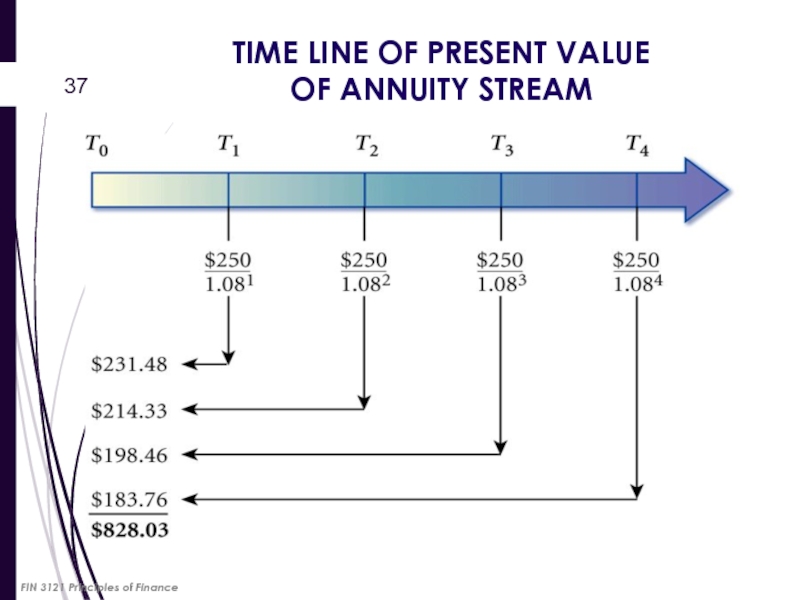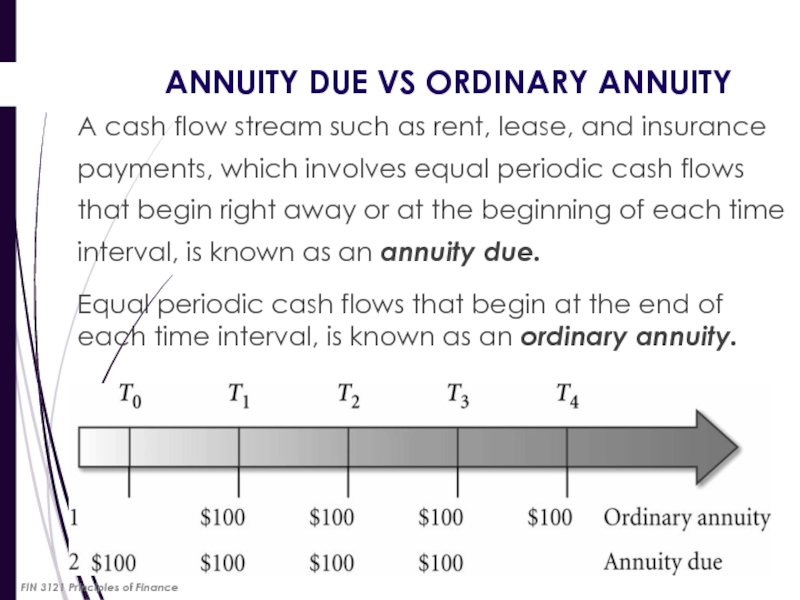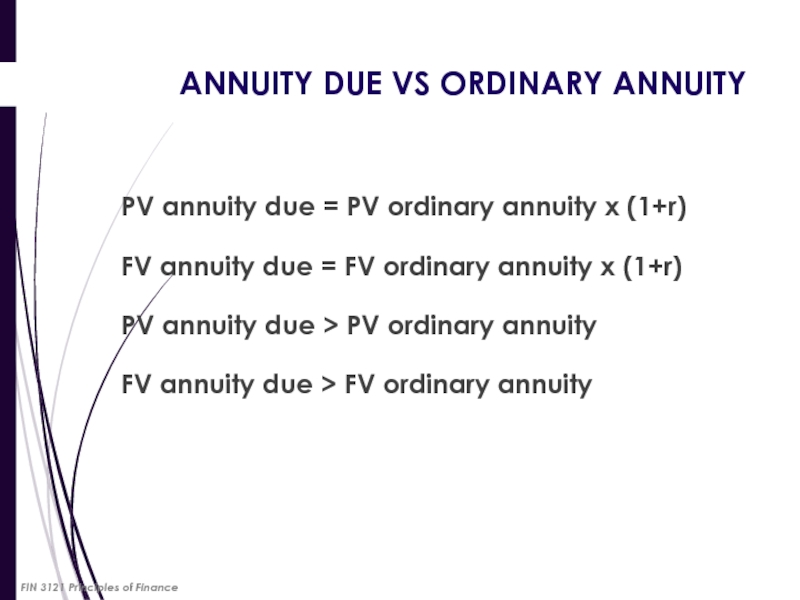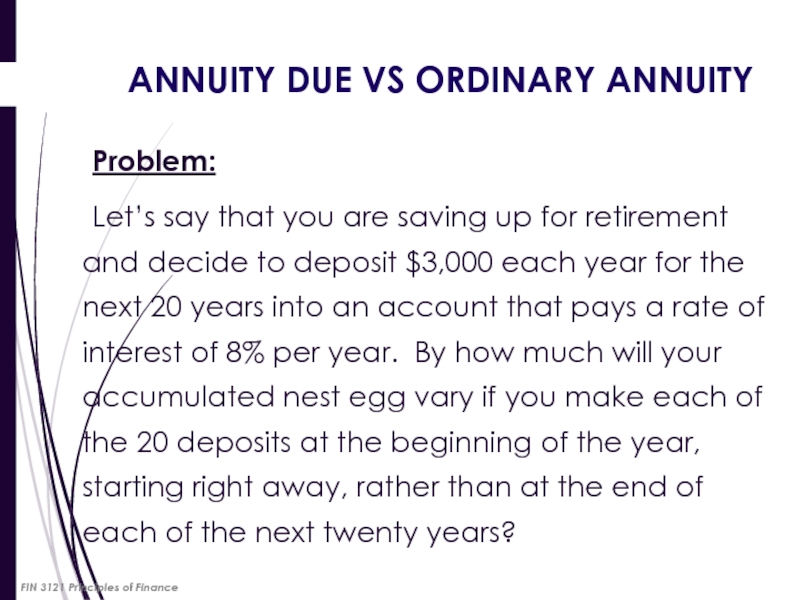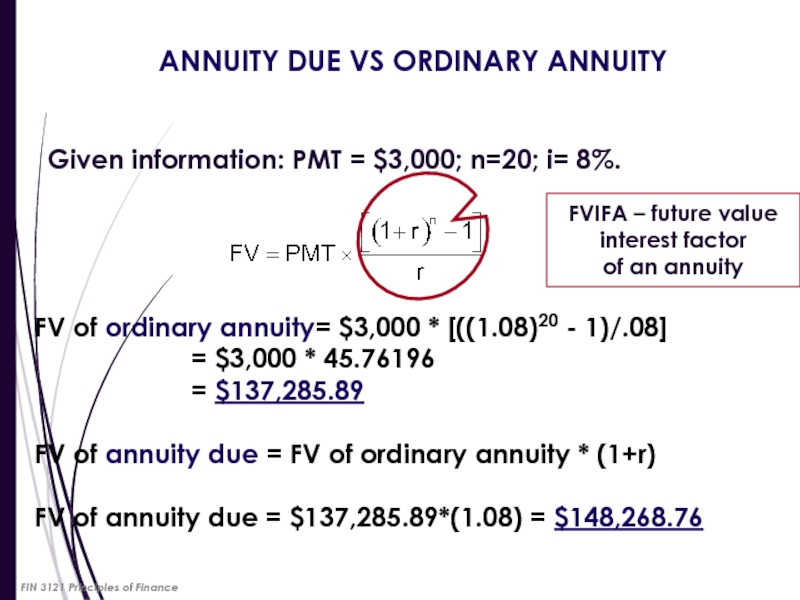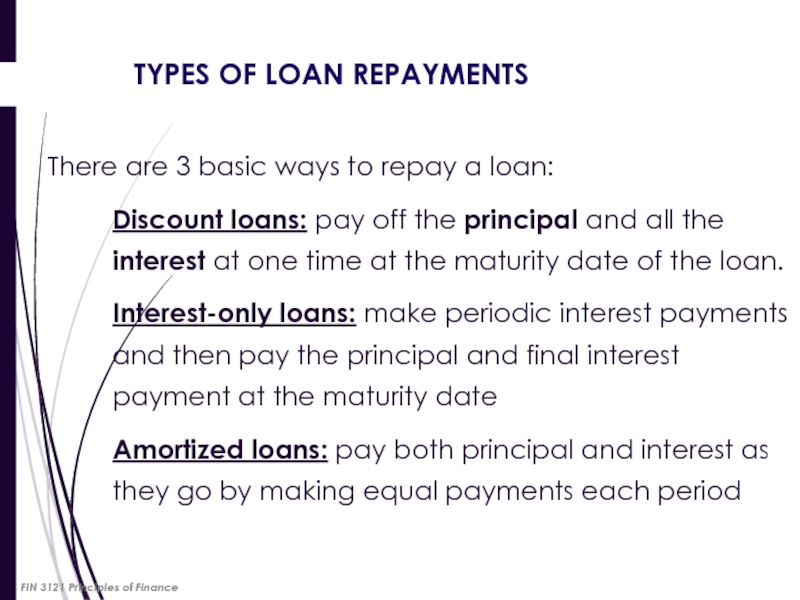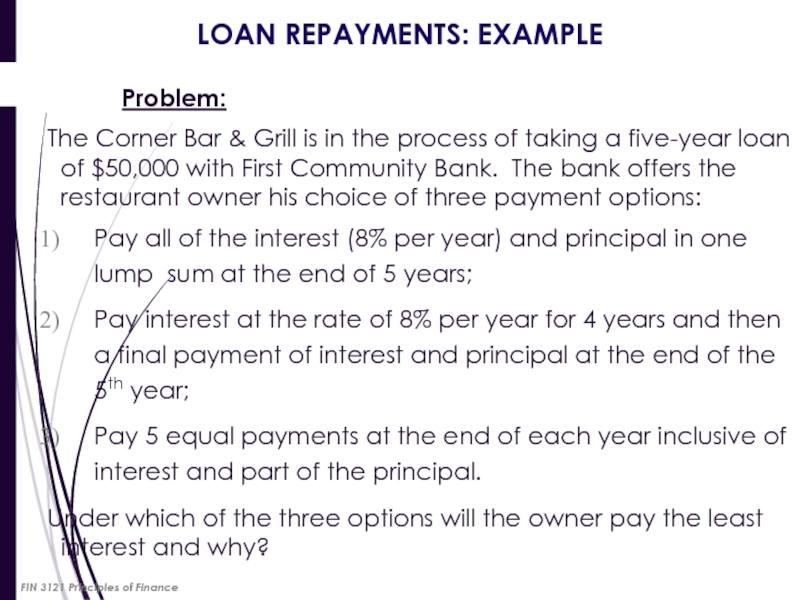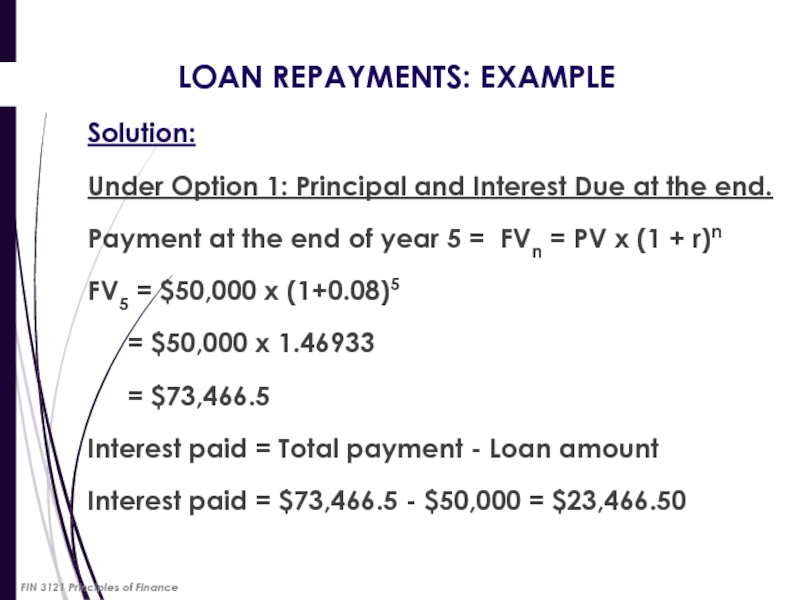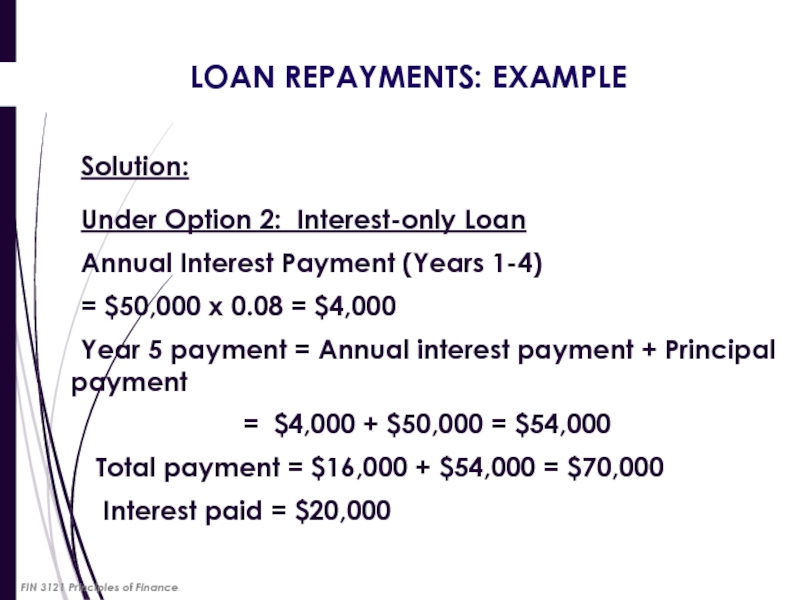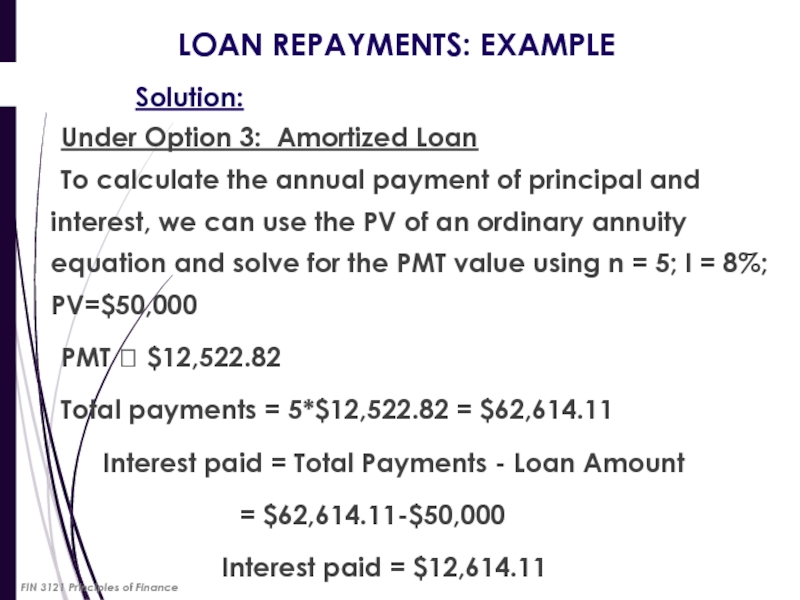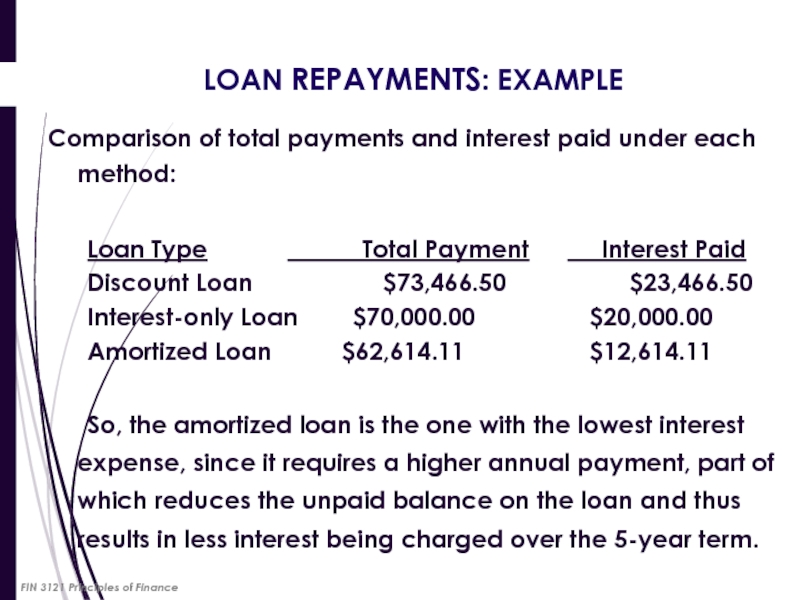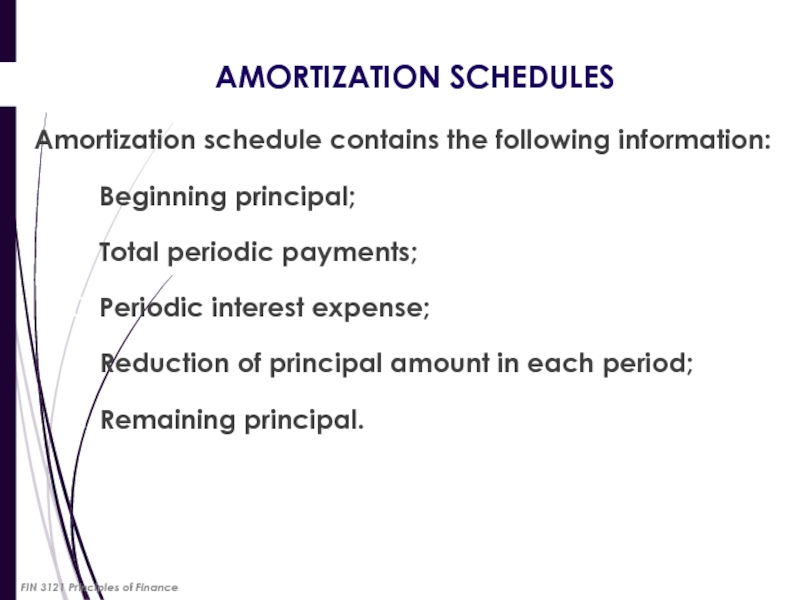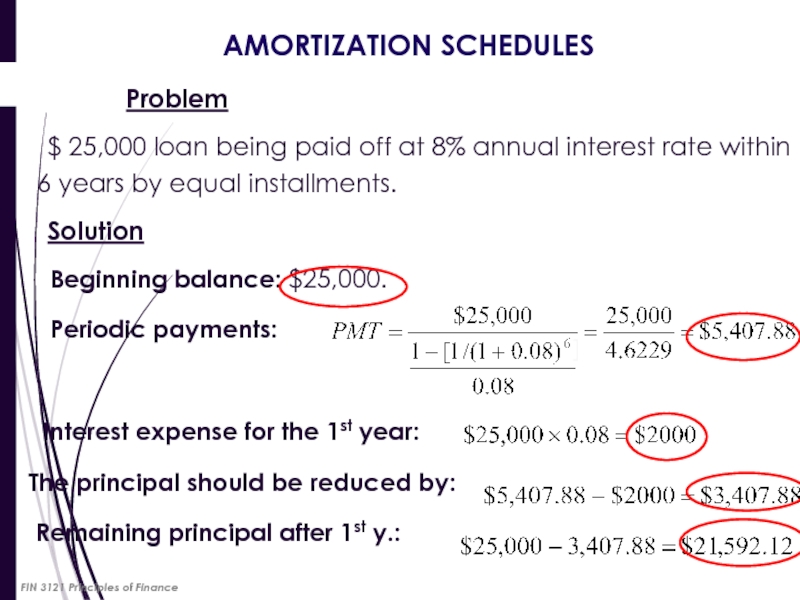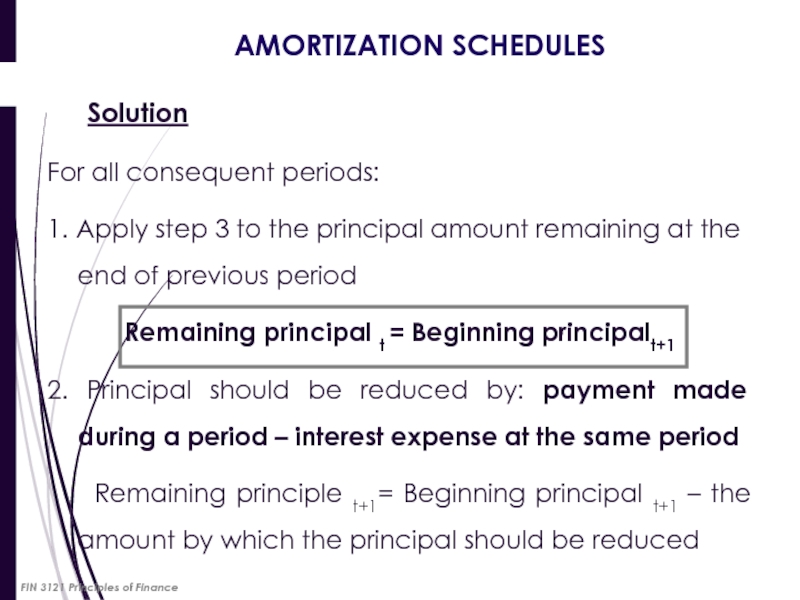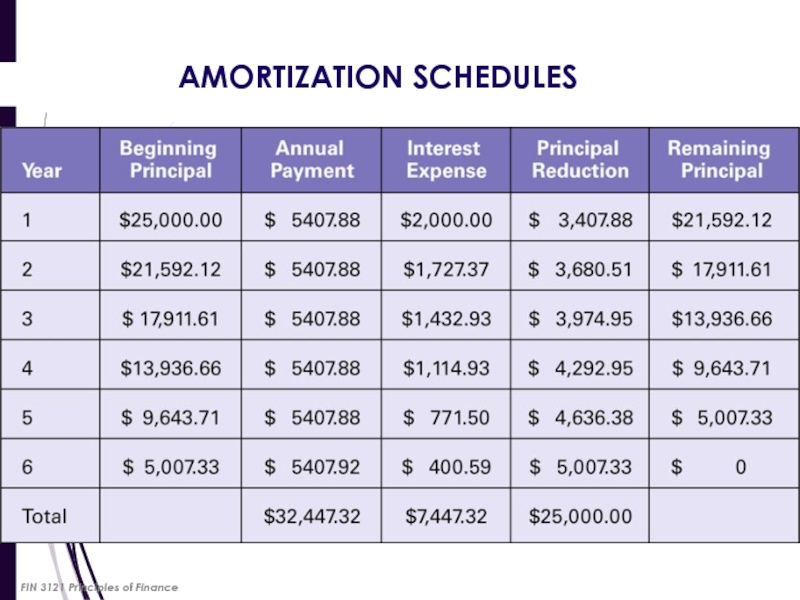- Главная
- Разное
- Дизайн
- Бизнес и предпринимательство
- Аналитика
- Образование
- Развлечения
- Красота и здоровье
- Финансы
- Государство
- Путешествия
- Спорт
- Недвижимость
- Армия
- Графика
- Культурология
- Еда и кулинария
- Лингвистика
- Английский язык
- Астрономия
- Алгебра
- Биология
- География
- Детские презентации
- Информатика
- История
- Литература
- Маркетинг
- Математика
- Медицина
- Менеджмент
- Музыка
- МХК
- Немецкий язык
- ОБЖ
- Обществознание
- Окружающий мир
- Педагогика
- Русский язык
- Технология
- Физика
- Философия
- Химия
- Шаблоны, картинки для презентаций
- Экология
- Экономика
- Юриспруденция
The time value of money. (Lecture 2) презентация
Содержание
- 1. The time value of money. (Lecture 2)
- 2. THE TIME VALUE OF MONEY (TVM) Money
- 3. COMPOUNDING VS. DISCOUNTING Compounding The process
- 4. SIMPLE INTEREST With Simple Interest, the interest
- 5. COMPOUNDING INTEREST With Compounding Interest, the interest
- 6. COMPOUNDING INTEREST 1776
- 7. THE TIMELINE A timeline is a linear
- 8. THE TIMELINE: EXAMPLE Problem Suppose you have
- 9. THE TIMELINE: EXAMPLE Solution
- 10. COMPOUNDING INTEREST FV=PV×(1+r)n FIN 3121 Principles of Finance
- 11. FREQUENCY OF COMPOUNDING There are 12 compounding
- 12. DISCOUNTING Discounting is a process of converting
- 13. DISCOUNTING If you can earn 5% interest
- 14. UNKNOWN VARIABLES Any time value
- 15. EXAMPLE: UNKNOWN RATE Problem Bank A offers
- 16. EXAMPLE: UNKNOWN RATE
- 17. EXAMPLE: UNKNOWN № OF PERIODS You have
- 18. RULE OF 72 The number of years
- 19. STREAM OF CASH FLOWS FIN 3121 Principles of Finance
- 20. ONLY VALUES AT THE SAME POINT IN
- 21. Valuing a Stream of Cash Flows General
- 22. where PV = the Present Value
- 23. Find the Present Value of the following
- 24. Future value of a stream of
- 25. Find the Future Value at the end
- 26. PERPETUITIES When a constant cash flow will
- 27. PERPETUITIES The value of a perpetuity is
- 28. PERPETUITIES: EXAMPLE Problem You want to donate
- 29. PERPETUITIES: EXAMPLE FIN 3121 Principles of Finance
- 30. When a constant cash flow will occur
- 31. ANNUITIES FIN 3121 Principles of Finance
- 32. FUTURE VALUE INTEREST FACTOR OF AN
- 33. FUTURE VALUE OF AN ORDINARY ANNUITY
- 34. FUTURE VALUE OF AN ORDINARY ANNUITY
- 35. FUTURE VALUE OF AN ORDINARY ANNUITY STREAM FIN 3121 Principles of Finance
- 36. PRESENT VALUE OF AN ANNUITY To calculate
- 37. TIME LINE OF PRESENT VALUE OF ANNUITY STREAM FIN 3121 Principles of Finance
- 38. ANNUITY DUE VS ORDINARY ANNUITY A cash
- 39. PV annuity due = PV ordinary annuity
- 40. ANNUITY DUE VS ORDINARY ANNUITY Problem: Let’s
- 41. ANNUITY DUE VS ORDINARY ANNUITY Given information:
- 42. TYPES OF LOAN REPAYMENTS There are 3
- 43. LOAN REPAYMENTS: EXAMPLE
- 44. LOAN REPAYMENTS: EXAMPLE Solution: Under Option 1:
- 45. LOAN REPAYMENTS: EXAMPLE Solution: Under Option 2:
- 46. LOAN REPAYMENTS: EXAMPLE
- 47. LOAN REPAYMENTS: EXAMPLE Comparison of total payments
- 48. AMORTIZATION SCHEDULES Amortization schedule contains the following
- 49. AMORTIZATION SCHEDULES
- 50. AMORTIZATION SCHEDULES Solution For all consequent
- 51. AMORTIZATION SCHEDULES FIN 3121 Principles of Finance
- 52. THE END FIN 3121 Principles of Finance
Слайд 2THE TIME VALUE OF MONEY (TVM)
Money (a dollar or a yen,
WHY?
You can invest it, earn interest, and end up with more in the future;
The purchasing power of money can change over time because of inflation.
The receipt of money expected in the future is, in general, uncertain.
TIME IS MONEY
FIN 3121 Principles of Finance
Слайд 3COMPOUNDING VS. DISCOUNTING
Compounding
The process of going from today’s value, or
Discounting
The process of going from future value (FV) to today’s value, or present value (PV)
Now Future
(PV) (FV)
Compounding
Discounting
Future value is the value of an asset in the future
that is equivalent in value to a specific amount today.
FIN 3121 Principles of Finance
Слайд 4SIMPLE INTEREST
With Simple Interest, the interest rate each year
is applied
Today Future Years
(PV) (FV)
FV=PV×(1+r×n)
PV = Present value
FV = Future value
r = interest rate, in decimal points
n = number of periods
FIN 3121 Principles of Finance
Слайд 5COMPOUNDING INTEREST
With Compounding Interest, the interest rate each year is applied
Simple interest
Compound interest
Today
Future years
FV=PV×(1+r)n
PV = Present value
FV = Future value
r = interest rate
n = number of periods
FVIF – future value
interest factor
FIN 3121 Principles of Finance
Слайд 6COMPOUNDING INTEREST
1776 1800
To see how much $2 investment
would have grown, compute FVs.
FV=PV×(1+r)n
$2×(1+0.06)24=$8
$2×(1+0.06)89=$357
$2×(1+0.06)153=$14 888
$2×(1+0.06)220=$738 449
FIN 3121 Principles of Finance
Слайд 7THE TIMELINE
A timeline is a linear representation of the timing of
Drawing a timeline of the cash flows will help you visualize the financial problem.
Differentiate between two types of cash flows
Inflows are positive cash flows.
Outflows are negative cash flows, which are indicated with a – (minus) sign.
FIN 3121 Principles of Finance
Слайд 8THE TIMELINE: EXAMPLE
Problem
Suppose you have a choice between receiving $5,000 today
FIN 3121 Principles of Finance
Слайд 9THE TIMELINE: EXAMPLE
Solution
The time line looks like this:
$5,000 × (1.10)5 = $8,053
The future value of $5,000 at 10% for five years is $8,053.
You would be better off forgoing the $5,000 today and taking the $9,500 in five years.
FIN 3121 Principles of Finance
Слайд 11FREQUENCY OF COMPOUNDING
There are 12 compounding events in Bank B
compared
The more frequent the compounding,
the larger the cumulative effect.
FV=PV×(1+r)n
FIN 3121 Principles of Finance
Слайд 12DISCOUNTING
Discounting is a process of converting values to be received or
The present value is determined from the amount to be received in a future and interest rate.
Interest rates used in the present value calculations are called “discount rates”.
1 FV
PV=FV× =
(1+r)n (1+r)n
PV = Present value
FV = Future value
r = discount rate
n = number of time periods
PVIF – present value
interest factor
FIN 3121 Principles of Finance
Слайд 13DISCOUNTING
If you can earn 5% interest compounded annually what do you
If you can earn 7% interest compounded annually what do you need to put on savings today to get an amount you need?
If you go to Europe 4 years from now with $5000 to spent and you can earn 5% interest compounded annually, what do you need to put on savings today?
FV
PV=
(1+r)n
FIN 3121 Principles of Finance
Слайд 14UNKNOWN VARIABLES
Any time value problem involving lump sums --
If 3 out of 4 variables are given, we can solve for the unknown one.
? solving for future value
? solving for present value
? solving for unknown rate
? solving for # of periods
FV
PV=
(1+r)n
FV=PV×(1+r)n
n =
FIN 3121 Principles of Finance
Слайд 15EXAMPLE: UNKNOWN RATE
Problem
Bank A offers to pay you a lump sum
Bank B, on the other hand, says that they will pay you a lump sum of $22,000 after 5 years if you deposit $10,700 with them today.
Which offer should you accept, and why?
FIN 3121 Principles of Finance
Слайд 16EXAMPLE: UNKNOWN RATE
Solution
To answer this question, you have to calculate the rate of return that will be earned on each investment and accept the one that has the higher rate of return.
Bank A’s Offer:
Rate = (FV/PV)1/n - 1 = ($20,000/$9,500)1/5 – 1 = 1.16054 - 1 = 16.054%
Bank B’s Offer:
Rate = (FV/PV)1/n - 1 = ($22,000/$10,700)1/5 – 1 = 1.15507 - 1 = 15.507%
You should accept Bank A’s offer, since it provides a higher annual rate of return i.e 16.05%.
FIN 3121 Principles of Finance
Слайд 17EXAMPLE: UNKNOWN № OF PERIODS
You have decided that you will sell
If houses are appreciating at an average annual rate of 4.5% in your neighborhood, for approximately how long will you be staying in the house?
Solution
n =
n =[ ln(450,000/(300,000])/[ln(1.045)]
= .40547 / .04402 = 9.21 years
FIN 3121 Principles of Finance
Слайд 18RULE OF 72
The number of years it takes for a sum
If you start with $1000 and r=10%, you will have $2000 after 7.2 years, 4000 after 14.4 years, $8000 after 21.6 years, and so on.
72
Doubling time =
Interest rate
FIN 3121 Principles of Finance
Слайд 20ONLY VALUES AT THE SAME POINT IN TIME
CAN BE COMPARED
FIN 3121 Principles of Finance
Слайд 21Valuing a Stream of Cash Flows
General formula for valuing a stream
if we want to find the present value of a stream of cash flows, we simply add up the present values of each.
if we want to find the future value of a stream of cash flows, we simply add up the future values of each.
FIN 3121 Principles of Finance
Слайд 22where
PV = the Present Value of the Cash Flow Stream,
CFt = the cash flow which occurs at the end of year t,
r = the discount rate,
t = the year, which ranges from zero to n, and
n = the last year in which a cash flow occurs.
Present value
of a stream of cash flows
FIN 3121 Principles of Finance
Слайд 23Find the Present Value of the following cash flow stream given
Present value
of a stream of cash flows
FIN 3121 Principles of Finance
Слайд 24Future value
of a stream of cash flows
where
FVt
CFt = the cash flow which occurs at the end of year t
r = the discount rate
t = the year, which ranges from zero to n
n = the last year in which a cash flow occurs
FIN 3121 Principles of Finance
Слайд 25Find the Future Value at the end of year 4 of
Future value
of a stream of cash flows
FIN 3121 Principles of Finance
Слайд 26PERPETUITIES
When a constant cash flow will occur at regular intervals forever
FIN 3121 Principles of Finance
Слайд 27PERPETUITIES
The value of a perpetuity is simply the cash flow divided
Present Value of a Perpetuity:
In decimal points
FIN 3121 Principles of Finance
Слайд 28PERPETUITIES: EXAMPLE
Problem
You want to donate to your University to endow an
If the University earns 8% per year on its investments, and the first party is in one year’s time, how much will you need to donate to endow the party?
FIN 3121 Principles of Finance
Слайд 30When a constant cash flow will occur at regular intervals for
ANNUITIES
FIN 3121 Principles of Finance
Слайд 32FUTURE VALUE INTEREST FACTOR
OF AN ANNUITY (FVIFA)
FVIFA =
FVIFA –
interest factor of an annuity
FIN 3121 Principles of Finance
Слайд 33FUTURE VALUE OF
AN ORDINARY ANNUITY STREAM
Problem
Jill has been faithfully depositing
FIN 3121 Principles of Finance
Слайд 34FUTURE VALUE OF
AN ORDINARY ANNUITY STREAM
Solution
Future Value of Payment One
Future Value of Payment Two = $2,000 x 1.088 = $3,701.86
Future Value of Payment Three = $2,000 x 1.087 = $3,427.65
Future Value of Payment Four = $2,000 x 1.086 = $3,173.75
Future Value of Payment Five = $2,000 x 1.085 = $2,938.66
Future Value of Payment Six = $2,000 x 1.084 = $2,720.98
Future Value of Payment Seven = $2,000 x 1.083 = $2,519.42
Future Value of Payment Eight = $2,000 x 1.082 = $2,332.80
Future Value of Payment Nine = $2,000 x 1.081 = $2,160.00
Future Value of Payment Ten = $2,000 x 1.080 = $2,000.00
Total Value of Account at the end of 10 years $28,973.13
FIN 3121 Principles of Finance
Слайд 36PRESENT VALUE OF AN ANNUITY
To calculate the value of a series
PV = PMT×
PVIFA – present value
interest factor of an annuity
FIN 3121 Principles of Finance
Слайд 38ANNUITY DUE VS ORDINARY ANNUITY
A cash flow stream such as rent,
Equal periodic cash flows that begin at the end of each time interval, is known as an ordinary annuity.
FIN 3121 Principles of Finance
Слайд 39PV annuity due = PV ordinary annuity x (1+r)
FV annuity due
PV annuity due > PV ordinary annuity
FV annuity due > FV ordinary annuity
FIN 3121 Principles of Finance
ANNUITY DUE VS ORDINARY ANNUITY
Слайд 40ANNUITY DUE VS ORDINARY ANNUITY
Problem:
Let’s say that you are saving up
FIN 3121 Principles of Finance
Слайд 41ANNUITY DUE VS ORDINARY ANNUITY
Given information: PMT = $3,000; n=20; i=
FV of ordinary annuity= $3,000 * [((1.08)20 - 1)/.08]
= $3,000 * 45.76196
= $137,285.89
FV of annuity due = FV of ordinary annuity * (1+r)
FV of annuity due = $137,285.89*(1.08) = $148,268.76
FVIFA – future value
interest factor
of an annuity
FIN 3121 Principles of Finance
Слайд 42TYPES OF LOAN REPAYMENTS
There are 3 basic ways to repay a
Discount loans: pay off the principal and all the interest at one time at the maturity date of the loan.
Interest-only loans: make periodic interest payments and then pay the principal and final interest payment at the maturity date
Amortized loans: pay both principal and interest as they go by making equal payments each period
FIN 3121 Principles of Finance
Слайд 43LOAN REPAYMENTS: EXAMPLE
Problem:
The Corner
Pay all of the interest (8% per year) and principal in one lump sum at the end of 5 years;
Pay interest at the rate of 8% per year for 4 years and then a final payment of interest and principal at the end of the 5th year;
Pay 5 equal payments at the end of each year inclusive of interest and part of the principal.
Under which of the three options will the owner pay the least interest and why?
FIN 3121 Principles of Finance
Слайд 44LOAN REPAYMENTS: EXAMPLE
Solution:
Under Option 1: Principal and Interest Due at the
Payment at the end of year 5 = FVn = PV x (1 + r)n
FV5 = $50,000 x (1+0.08)5
= $50,000 x 1.46933
= $73,466.5
Interest paid = Total payment - Loan amount
Interest paid = $73,466.5 - $50,000 = $23,466.50
FIN 3121 Principles of Finance
Слайд 45LOAN REPAYMENTS: EXAMPLE
Solution:
Under Option 2: Interest-only Loan
Annual Interest Payment (Years 1-4)
= $50,000 x 0.08 = $4,000
Year 5 payment = Annual interest payment + Principal payment
= $4,000 + $50,000 = $54,000
Total payment = $16,000 + $54,000 = $70,000
Interest paid = $20,000
FIN 3121 Principles of Finance
Слайд 46LOAN REPAYMENTS: EXAMPLE
Solution:
Under Option 3: Amortized
To calculate the annual payment of principal and interest, we can use the PV of an ordinary annuity equation and solve for the PMT value using n = 5; I = 8%; PV=$50,000
PMT ? $12,522.82
Total payments = 5*$12,522.82 = $62,614.11
Interest paid = Total Payments - Loan Amount
= $62,614.11-$50,000
Interest paid = $12,614.11
FIN 3121 Principles of Finance
Слайд 47LOAN REPAYMENTS: EXAMPLE
Comparison of total payments and interest paid under each
Loan Type Total Payment Interest Paid
Discount Loan $73,466.50 $23,466.50
Interest-only Loan $70,000.00 $20,000.00
Amortized Loan $62,614.11 $12,614.11
So, the amortized loan is the one with the lowest interest expense, since it requires a higher annual payment, part of which reduces the unpaid balance on the loan and thus results in less interest being charged over the 5-year term.
FIN 3121 Principles of Finance
Слайд 48AMORTIZATION SCHEDULES
Amortization schedule contains the following information:
Beginning principal;
Total periodic payments;
Periodic interest expense;
Reduction of principal amount in each period;
Remaining principal.
FIN 3121 Principles of Finance
Слайд 49AMORTIZATION SCHEDULES
Problem
$ 25,000 loan
Solution
Beginning balance: $25,000.
Periodic payments:
Interest expense for the 1st year:
The principal should be reduced by:
Remaining principal after 1st y.:
FIN 3121 Principles of Finance
Слайд 50AMORTIZATION SCHEDULES
Solution
For all consequent periods:
1. Apply step 3 to the
Remaining principal t = Beginning principalt+1
2. Principal should be reduced by: payment made during a period – interest expense at the same period
Remaining principle t+1= Beginning principal t+1 – the amount by which the principal should be reduced
FIN 3121 Principles of Finance
